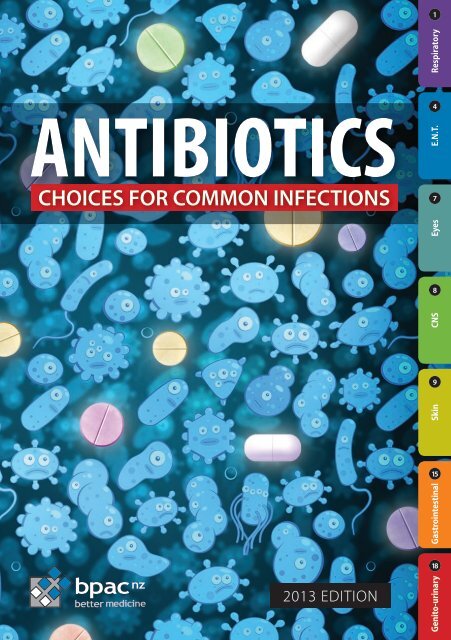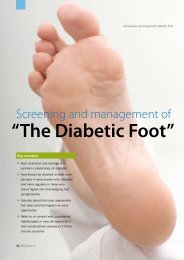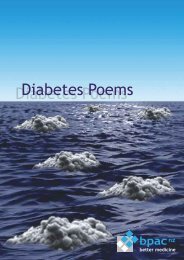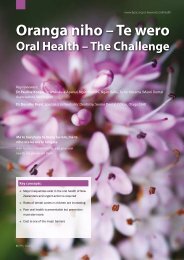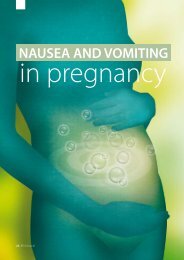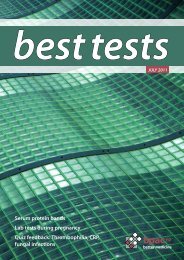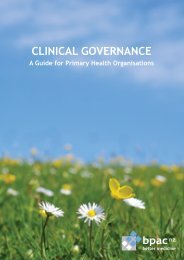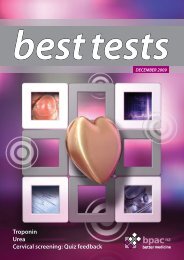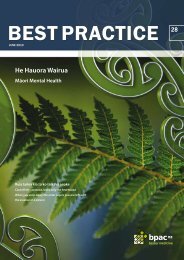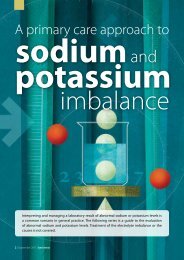Download Antibiotics Guide - Bpac.org.nz
Download Antibiotics Guide - Bpac.org.nz
Download Antibiotics Guide - Bpac.org.nz
Create successful ePaper yourself
Turn your PDF publications into a flip-book with our unique Google optimized e-Paper software.
1RespiratoryANTIBIOTICSCHOICES FOR COMMON INFECTIONS4E.N.T.7Eyes8bpac <strong>nz</strong>2013 EDITIONbetter medicineGenito-urinary Gastrointestinal SkinCNS91518
Antibiotic choices for common infectionsIncreasing antimicrobial resistance is now a worldwide problem, compounded by thelack of development of new antimicrobial medicines. This leaves the prudent use ofantimicrobial medicines, along with infection control, as the major strategies to counterthis emerging threat.A safe and effective strategy for antibiotic use involves prescribing an antibioticonly when it is needed and selecting an appropriate and effective medicine at therecommended dose, with the narrowest spectrum of antimicrobial activity, fewestadverse effects and lowest cost.General principles of antibiotic prescribing:1. Only prescribe antibiotics for bacterial infections if:■ Symptoms are significant or severe■ There is a high risk of complications■ The infection is not resolving or is unlikely to resolve2. Use first-line antibiotics first3. Reserve broad spectrum antibiotics for indicated conditions onlyThe following information is a consensus guide. It is intended to aid selection of anappropriate antibiotic for typical patients with infections commonly seen in generalpractice. Individual patient circumstances and local resistance patterns may altertreatment choices.Subsidy information for medicines has not been included in the guide as this is subjectto change. Fully-subsidised medicines should be prescribed as first-line choices,where possible. To check the subsidy status of a medicine see the New ZealandFormulary at: www.<strong>nz</strong>formulary.<strong>org</strong> or the Pharmaceutical Schedule online at:www.pharmac.health.<strong>nz</strong>Data on national resistance patterns are available from the Institute of EnvironmentalScience and Research Ltd (ESR), Public Health Surveillance: www.surv.esr.cri.<strong>nz</strong>Regional resistance patterns may vary slightly, check with your local laboratory.For an electronic version of this guide see:www.bpac.<strong>org</strong>.<strong>nz</strong>/antibioticsThe information in this guide is correct as at the time of publication (July, 2013).
RespiratoryCOPD – acute exacerbationsRespiratoryManagementCommon pathogensAntibiotic treatmentFirst choiceAlternativesMany exacerbations are triggered by viruses and antibiotictreatment provides limited benefit. Antibiotic treatment is mosthelpful in patients with severe exacerbations (e.g. purulentsputum and increased shortness of breath and/or increasedvolume of sputum) and those with more severe airflowobstruction at baseline.Respiratory viruses, Streptococcus pneumoniae, Haemophilusinflue<strong>nz</strong>ae, Moraxella catarrhalisAcute exacerbation of COPDAmoxicillinAdult: 500 mg, three times daily, for five daysDoxycyclineAdult: 200 mg, on day one (loading dose), followed by 100 mg,once daily, on days two to fivePertussis (Whooping cough)ManagementCommon pathogensAntibiotic treatment is recommended to reduce transmission, ifinitiated within three weeks of the onset of the cough, as after thistime most people are no longer infectious. Antibiotic treatment isunlikely to alter the clinical course of the illness unless given early(in the catarrhal stage).If the duration of the cough is unknown, give antibiotic treatment.Women who are in their third trimester of pregnancy should alsoreceive antibiotic treatment, regardless of the duration of cough.The patient should be advised to avoid contact with others,especially infants and children, until at least five days of antibiotictreatment has been taken.Prophylactic antibiotics are recommended for high risk contacts:children aged less than one year, people caring for childrenaged less than one year, pregnant women, and people at risk ofcomplications, e.g. severe asthma, immunocompromised.Bordetella pertussiscontinued over page1
RespiratoryRespiratory (continued)Antibiotic treatmentPertussis (Whooping cough)First choiceAlternativesAzithromycin (first-line for children, alternative for adults)Child < 45 kg: 10 mg/kg/dose, once daily, on day one, followed by5 mg/kg/dose, once daily, on days two to fiveAdult and Child > 45 kg: 500 mg on day one, followed by 250 mg,once daily, on days two to fiveErythromycin (first-line for adults, alternative for children agedover one year)Child: 10 mg/kg/dose, four times daily, for 14 daysAdult: 400 mg, four times daily, for 14 daysN.B. Erythromycin ethyl succinate is currently the only fully subsidisedform of oral erythromycin available in New Zealand. Treatmentand prophylaxis is recommended for 14 days with erythromycinethyl succinate. There is evidence that seven days of treatmentwith erythromycin estolate (which has superior tissue and serumconcentrations compared with the other erythromycin salts), is as effectiveas 14 days treatment. However, erythromycin estolate is not currentlyavailable in New Zealand.NonePneumonia – adultManagementCommon pathogensChest x-ray is not routinely recommended, however, it may beappropriate when the diagnosis is unclear, there is dullness topercussion or other signs of an effusion or collapse, and when thelikelihood of malignancy is increased, such as in a smoker agedover 50 years.Patients with one or more of the following features: age > 65years, confusion, respiratory rate >30/min, systolic BP < 90 mmHg, diastolic BP
Antibiotic treatmentFirst choiceAlternativesPneumonia – adultAmoxicillinAdult: 500 mg – 1 g, three times daily, for five to seven daysIf M. pneumoniae, C. pneumoniae or L. pneumophila are suspectedor if the patient has not improved after 48 hours, add eitherroxithromycin 300 mg, once daily, for seven days or doxycycline200 mg, twice daily * , on day one, followed by 100 mg, twice daily,from days two to seven* Increased dose as recommended by ADHB pneumonia guidelinesMonotherapy with roxithromycin or doxycycline is acceptablefor people with a history of penicillin allergy.RespiratoryPneumonia – childManagementCommon pathogensAntibiotic treatmentFirst choiceAlternativesReferral to hospital should be considered for any child with one ormore of the following factors: aged less than six months, drinkingless than half their normal amount, oxygen saturation ≤92%on pulse oximetry, severe tachypnoea, decreased respiratoryeffort, temperature < 35°C or > 40°C, decreased breath sounds ordullness to percussion, difficult to rouse.In addition, if there is no response to treatment in 24 – 48 hours,review diagnosis and consider referral to hospital.Respiratory viruses, Streptococcus pneumoniae, Haemophilusinflue<strong>nz</strong>ae, Mycoplasma pneumoniae, Staphylococcus aureusPneumonia – childAmoxicillinChild: 25 – 30 mg/kg/dose, three times daily, for five to seven days(maximum 500 mg/dose age three months to five years, 1000 mg/dose age > five years)ErythromycinChild: 10 – 12.5 mg/kg/dose, four times daily, for seven daysN.B. Can be first-line in school-aged children where the likelihood ofatypical pathogens is higher.RoxithromycinChild: 4 mg/kg/dose, twice daily, for seven to ten daysN.B. Only available in tablet form, therefore only if the child can swallowtablets; whole or half tablets may be crushed.3
Ear, nose and throatOtitis externa – acuteE.N.T.ManagementCommon pathogensAntibiotic treatmentFirst choiceAlternativesGentle debridement of the ear canal may be necessary to enhancethe effectiveness of topical treatment. Suction cleaning is also asafe and effective method of debridement.Most topical antibacterials are contraindicated in the presence ofa perforated drum or grommets, however, they may need to beused if other treatment options have been unsuccessful.Staphylococcus aureus, Streptococcus pyogenes, Pseudomonasaeruginosa, polymicrobial infectionsOtitis externa (acute)Clioquinol + flumethasone (Locorten Vioform)*Adult and child > 2 years: 2 to 3 drops, twice daily, for 7 daysORDexamethasone + framycetin + gramicidin (Sofradex)*Adult and child: 2 to 3 drops, three to four times daily, for 7 daysAvoid excessive use, e.g. for longer than one week, as this mayresult in fungal infection which can be difficult to treatAcetic acid 2% (Vosol)* may be sufficient in mild cases.Ciprofloxacin + hydrocortisone (Ciproxin HC)* if Pseudomonassuspected.Flucloxacillin if there is spreading cellulitis or the patient issystemically unwell; also consider referral to hospital.* Currently subsidised brandOtitis mediaManagementCommon pathogensAntibiotic treatment is usually unnecessary.Consider antibiotics for children at high risk such as those withsystemic symptoms, aged less than six months, aged less thantwo years with severe or bilateral disease, or with perforation and/or otorrhoea. Also consider antibiotics in children who have hadmore than three episodes of otitis media.Otherwise treat symptomatically, e.g. paracetamol, and arrangefollow up or give a “back pocket” prescription to be dispensed ifno improvement in next 24 – 48 hours.Respiratory viruses, Streptococcus pneumoniae, Haemophilusinflue<strong>nz</strong>ae, Moraxella catarrhalis4
Antibiotic treatmentFirst choiceAlternativesOtitis mediaAmoxicillinChild: 15 mg/kg/dose, three times daily, for five days (seven toten days if age < two years, underlying medical condition orperforated ear drum)Use 30 mg/kg/dose, three times daily, for five to seven days insevere or recurrent infection (maximum 500 mg/dose age threemonths to five years, 1000 mg/dose age > five years)Co-trimoxazoleChild > 6 weeks: 0.5 mL/kg/dose oral liquid (40+200 mg/5 mL),twice daily, for five to seven days (maximum 20 mL/dose)If a child can swallow tablets, co-trimoxazole 80+400 mg tabletscan be used (one tablet is equivalent to 10 mL of co-trimoxazoleoral liquid)N.B. Co-trimoxazole should be avoided in infants aged under six weeks,due to the risk of hyperbilirubinaemia.E.N.T.PharyngitisManagementCommon pathogensMost pharyngitis is of viral origin. The major benefit of treatingStreptococcus pyogenes pharyngitis is to prevent rheumatic fever,therefore antibiotic treatment is recommended for those atincreased risk of rheumatic fever, i.e. if the patient has a history ofpast rheumatic fever, is of Maori or Pacific ethnicity, or is living in alower socioeconomic area of the North Island, and is aged 3 – 45years. Patients who fulfil one or more of these criteria, and whohave features of group A streptococcus infection: temperature>38°C, tender cervical nodes, tonsillar swelling or exudate, and nocough, especially if aged 3–14 years, should have a throat swabtaken and empiric antibiotic treatment either started immediatelyor if Streptococcus pyogenes is isolated from the swab.Avoid amoxicillin if infectious mononucleosis (EBV) is suspecteddue to an increased risk of rash.Respiratory viruses, Streptococcus pyogenescontinued over page5
Ear, nose and throat (continued)Antibiotic treatmentPharyngitisE.N.T.First choice Phenoxymethylpenicillin (Penicillin V)Child: 10 mg/kg/dose, twice daily, for ten days (maximum 500mg/dose)Adult: 500 mg, twice daily, for ten daysORAmoxicillinChild 30 kg: 1500 mg, once daily, for ten daysOR (if compliance is likely to be an issue)IM be<strong>nz</strong>athine penicillin (stat)Child < 20 kg: 450 mg (600 000 U)Child > 20 kg: 900 mg (1 200 000 U)Adult: 900 mg (1 200 000 U)AlternativesErythromycinChild: 20 mg/kg/dose, twice daily or 10 mg/kg/dose, four timesdaily, for ten days (maximum 1 g/day)Adult: 400 mg, twice daily, for ten daysN.B. Co-trimoxazole does not have reliable activity against S. pyogenes oreradicate pharyngeal carriage and should not be used.Sinusitis – acuteManagementCommon pathogensAntibiotic treatmentFirst choiceMost patients with sinusitis will not have a bacterial infection.Even for those that do, antibiotics only offer a marginal benefitand symptoms will resolve in most patients in 14 days, withoutantibiotics.Consider antibiotics for patients with severe sinusitis symptoms(e.g. purulent nasal discharge, nasal congestion and/or facialpain or pressure) for more than five to seven days plus any of thefollowing features: fever, unilateral maxillary sinus tenderness,severe headache, symptoms worsening after initial improvement.Respiratory viruses, Streptococcus pneumoniae, Haemophilusinflue<strong>nz</strong>ae, Moraxella catarrhalis, anaerobic bacteriaSinusitis (acute)AmoxicillinChild: 15 mg/kg/dose, three times daily, for seven daysUse 30 mg/kg/dose, three times daily, for seven days in severe orrecurrent infection (maximum 500 mg/dose age three months tofive years, 1000 mg/dose age > five years)6
Antibiotic treatmentAlternativesSinusitis (acute) – continuedDoxycyclineAdult and child > 12 years: 200 mg on day one, followed by 100mg, once daily, on days two to sevenAmoxicillin clavulanate (if symptoms persist despite a treatmentcourse of amoxicillin)Child: 10 mg/kg/dose (amoxicillin component), three times daily,for seven days (maximum 500 mg/dose amoxicillin component)Adult: 500+125 mg, three times daily, for seven daysEyesEyesConjunctivitisManagementCommon pathogensAntibiotic treatmentFirst choiceAlternativesCan be viral, bacterial or allergic. Bacterial infection is usuallyassociated with mucopurulent discharge.Most bacterial conjunctivitis is self-limiting and the majority ofpeople improve without treatment, in two to five days.In newborn infants, consider Chlamydia trachomatis or Neisseriagonorrhoeae, in which case, do not use topical treatment. Collecteye swabs, and refer to a Paediatrician.Viruses, Streptococcus pneumoniae, Haemophilus influe<strong>nz</strong>ae,Staphylococcus aureusLess commonly: Chlamydia trachomatis or Neisseria gonorrhoeaeConjunctivitisChloramphenicol 0.5% eye dropsAdult and child > 2 years: 1 – 2 drops, every two hours for thefirst 24 hours, then every four hours +/– chloramphenicol eyeointment at night until 48 hours after symptoms have clearedFusidic acid eye gelAdult and child: 1 drop, twice daily until 48 hours after symptomshave clearedPeriorbital cellulitis – see Cellulitus (Page 11)7
CNSBacterial meningitis and suspected meningococcal sepsisManagementCommon pathogensAntibiotic treatmentImmediately refer all people with suspected meningococcaldisease (meningitis with non-blanching rash or meningococcalsepticaemia) or bacterial meningitis (without a non-blanchingrash) to hospital. Give be<strong>nz</strong>ylpenicillin before transport tohospital, as long as this does not delay the transfer.Notifiable on suspicion.Neisseria meningitidis, Streptococcus pneumoniaeLess common: Listeria monocytogenes, Haemophilus influe<strong>nz</strong>aeBacterial meningitis and suspected meningococcal sepsisFirst choice Be<strong>nz</strong>ylpenicillin (penicillin G)Child < one year: 300 mg IV or IMChild one to nine years: 600 mg IV or IMAdult and child > ten years: 1.2 g IV or IMCNSAlternativesCeftriaxoneAdult and child: 50 – 100 mg/kg up to 2 g IV or IMN.B. Almost any parenterally administered antibiotic in an appropriatedosage will inhibit the growth of meningococci, so if be<strong>nz</strong>ylpenicillin orceftriaxone are not available, give any other penicillin or cephalosporinantibiotic.8
SkinBites – human and animal (Includes injury to fist from contact with teeth)ManagementCommon pathogensAntibiotic treatmentFirst choiceAlternativesClean and debride wound thoroughly and assess the need fortetanus immunisation.All infected bites should be treated with antibiotics. Prophylacticantibiotic treatment is appropriate for human and cat bites, or dogbites if severe or deep, and any bites that occur to the hand, foot,face, tendon or ligament, or in immunocompromised people.Consider referral to hospital if there is bone or joint involvement.Polymicrobial infection, Pasteurella multocida, Capnocytophagacanimorsus (cat and dog bites), Eikenella corrodens (fist injury),Staphylococcus aureus, streptococci and anaerobesBites – human and animalAmoxicillin clavulanateChild: 10 mg/kg/dose (amoxicillin component), three times daily,for seven days (maximum 500 mg/dose, amoxicillin component)Adult: 500+125 mg, three times daily, for seven daysAdult and child > 12 years: Metronidazole 400 mg, three timesdaily, + doxycycline 200 mg on day one, followed by 100 mg, oncedaily, on days two to sevenMetronidazole + co-trimoxazole is an alternative for childrenaged under 12 years (doxycycline contraindicated)Skin9
Skin (continued)BoilsSkinManagementCommon pathogensAntibiotic treatmentFirst choiceAlternativesMost lesions may be treated with incision and drainage alone.<strong>Antibiotics</strong> may be considered if there is fever, surroundingcellulitis or co-morbidity, e.g. diabetes, or if the lesion is in a siteassociated with complications, e.g. face.For management of recurrent boils, see: “Recurrent skin infections”(Page 14).Staphylococcus aureusConsider MRSA if there is a lack of response to flucloxacillin.BoilsFlucloxacillinChild: 12.5 mg/kg/dose, three to four times daily, for seven daysAdult: 500 mg, four times daily, for five to seven daysOR (if flucloxacillin not tolerated in children)CephalexinChild: 12.5 – 25 mg/kg/dose, twice daily, for five to seven daysCephalexinAdult: 500 mg, four times daily, for five to seven daysErythromycinChild aged < 12 years: 20 mg/kg/dose, twice daily, or 10 mg/kg/dose, four times daily, for five to seven days (maximum 1 g/day)Adult: 800 mg, twice daily, or 400 mg, four times daily, for five toseven daysCo-trimoxazole (if MRSA present):Child > 6 weeks: 0.5 mL/kg oral liquid (40+200 mg/ 5 mL), twicedaily, for five to seven days (maximum 20 mL/dose)N.B. Co-trimoxazole should be avoided in infants aged under six weeks, due tothe risk of hyperbilirubinaemia.Adult and child >12 years: 160+800 mg (two tablets), twice daily,for five to seven days10
CellulitisManagementCommon pathogensAntibiotic treatmentFirst choiceAlternativesKeep affected area elevated (if applicable) for comfort and torelieve oedema. Assess response to treatment in seven days.Consider referral for IV antibiotics if cellulitis is severe or systemicsymptoms are present, e.g. fever, nausea, vomiting.For periorbital or facial cellulitis, in all but very mild casesconsider referral for IV antibiotics.Streptococcus pyogenes, Staphylococcus aureus, Group C or GroupG streptococciCellulitisFlucloxacillinChild: 12.5 mg/kg/dose, four times daily, for seven daysAdult: 500 mg, four times daily, for five to seven daysOR (if flucloxacillin not tolerated)CephalexinChild: 12.5 mg/kg/dose, four times daily, for seven to ten days(maximum 500 mg/dose)Adult: 500 mg, four times daily, for seven daysErythromycinChild < 12 years: 20 mg/kg/dose, twice daily, or 10 mg/kg/dose,four times daily, for seven to ten days (maximum 1 g/day)Adult: 800 mg, twice daily, or 400 mg, four times daily, for sevendaysCo-trimoxazole (if MRSA present):Child > 6 weeks: 0.5 mL/kg/dose oral liquid (40+200 mg/5 mL),twice daily, for five to seven days (maximum 20 mL/dose)N.B. Co-trimoxazole should be avoided in infants aged under six weeks, due tothe risk of hyperbilirubinaemia.Adult and child aged over 12 years: 160+800 mg (two tablets),twice daily, for five to seven daysSkin11
Skin (continued)Diabetic foot infectionsManagementCommon pathogensAntibiotic treatmentFirst choiceAlternatives<strong>Antibiotics</strong> (and culture) are not necessary unless there are signsof infection in the wound. However, in people with diabetesand other conditions where perfusion and immune responseare diminished, classical clinical signs of infection are not alwayspresent, so the threshold for suspecting infection and testing awound should be lower.Referral to hospital should be considered if it is suspected thatthe infection involves the bones of the feet, if there is no sign ofhealing after four weeks of treatment, or if other complicationsdevelop.Early infection is usually due to Staphylococcus aureus and/orstreptococci. Later infection may be polymicrobial with a mixtureof Gram-positive cocci, Gram-negative bacilli and anaerobes.Diabetic foot infectionsAmoxicillin clavulanateAdult: 500+125 mg, three times daily, for five to seven daysCephalexin 500 mg, four times daily, + metronidazole 400 mg,twice to three times daily, for five to seven daysOR (for patients with penicillin hypersensitivity)Co-trimoxazole 160+800 mg (two tablets), twice daily, +clindamycin * 300 mg, three times daily, for five to seven days* Requires specialist endorsement for > 4 capsulesSkinSkinImpetigoManagementRemove crusted area and apply topical antibiotic ointment tolocalised areas of impetigo. Keep affected areas covered andexclude from school or preschool until 24 hours after treatmentinitiated. Assess and treat other infected household members.Oral antibiotics are recommended for more extensive,widespread, impetigo, or if systemic symptoms are present.Recurrent impetigo may be the result of chronic nasal carriage ofStaphylococcus aureus (patient or household contact), or re-infectionfrom fomite colonisation, e.g. clothing, linen, and may requiredecolonisation. See: “Recurrent skin infections” (Page 14).N.B. Streptococcus pyogenes has caused outbreaks of necrotising fasciitisin residential care facilities, and if this is suspected it is important to usesystemic treatment to eradicate carriage, and prevent infection to others.12
Common pathogensAntibiotic treatmentFirst choiceAlternativesStreptococcus pyogenes, Staphylococcus aureusImpetigoTopical (localised patches):Fusidic acid 2% cream or ointment applied three times daily,for seven daysOral (extensive lesions):FlucloxacillinChild: 12.5 mg/kg/dose four times daily, for seven days(maximum 500 mg/dose)Adult: 500 mg, four times daily, for seven daysORCephalexinChild: 12–25 mg/kg/dose, twice daily, for seven daysAdult: 500 mg, four times daily or 1 g, twice daily, for seven daysIf topical treatment fails, use oral treatment as above.Erythromycin (alternative oral treatment)Child aged < 12 years: 20 mg/kg/dose, twice daily, or 10 mg/kg/dose, four times daily, for seven to ten days (maximum 1 g/day)Adult: 800 mg, twice daily, or 400 mg, four times daily, for sevendaysCo-trimoxazole (if MRSA present)Child > 6 weeks: 0.5 mL/kg/dose oral liquid (40+200 mg/5 mL),twice daily, for five to seven days (maximum 20 mL/dose)N.B. Co-trimoxazole should be avoided in infants aged under six weeks,due to the risk of hyperbilirubinaemia.Adult and child > 12 years: 160+800 mg (two tablets), twice daily,for five to seven daysSkinMastitisManagementCommon pathogensAntibiotic treatmentFirst choiceTreat with antibiotic and continue to breast feed from bothbreasts. This is an important component of treatment and posesno risk to the infant.Staphylococcus aureus in lactating women, S. aureus andanaerobes in non-lactating females, or in malesMastitisFlucloxacillinAdult: 500 mg, four times daily, for seven days13
Skin (continued)Antibiotic treatmentAlternativesMastitis – continuedCephalexinAdult: 500 mg, four times daily, for seven daysErythromycinAdult: 400 mg, four times daily, for seven daysTreat mastitis in males or non-lactating females with amoxicillinclavulanate 500+125 mg, three times daily, for seven daysRecurrent skin infectionsSkinSkinManagementTake a swab of the lesion to rule out MRSA infection.Decolonisation should not be attempted until the lesions havehealed. Take a nasal swab and if indicated by results, performstaphylococcal decolonisation.The patient should be advised to shower daily for one week usingtriclosan 1% or chlorhexidine 4% body wash, applied with aclean cloth, with special attention to axillae, groin and perineum.Also recommend hot drying, ironing or bleaching towels,facecloths, sheets, other linen and underclothes for the durationof treatment.For children, adding half cup of unscented household bleach(sodium hypochlorite 3–5%) to a bath, followed by a fresh waterrinse, two to three times weekly, may be effective and preferableto showering with triclosan, particularly if the child has underlyingatopic eczema.Treatment of other household contacts with recurrent infectionshould occur at the same time. There is some evidence that skininfections are reduced if these measures are performed for allhousehold contacts, but compliance and motivation may bebarriers.Antibiotic treatmentFirst choiceAlternatives14Recurrent skin infectionsFor clearance of staphylococcal carriage:Depending on susceptibilityFusidic acid 2% cream or ointmentMupirocin 2% ointment (usually reserved for MRSA)Apply inside the nostrils with a cotton bud or finger, twice daily,for five daysN.B. Excessive use of topical antibiotics has led to high rates of resistancein S. aureus.Nil
GastrointestinalCampylobacter enterocolitisManagementCommon pathogensAntibiotic treatmentFirst choiceMost people will recover with symptomatic treatment only.<strong>Antibiotics</strong> have little impact on the duration and severity ofsymptoms but eradicate stool carriage.Treatment is indicated for severe or prolonged infection,for pregnant women nearing term and for people who areimmunocompromised. Treatment may also be appropriatefor food handlers, childcare workers and those caring forimmunocompromised patients.Campylobacter enterocolitis is a notifiable disease.Campylobacter jejuniCampylobacter enterocolitisErythromycinChild: 10 mg/kg/dose, four times daily, for five daysAdult: 400 mg, four times daily, for five daysClostridium difficile colitisManagementCommon pathogensDisease is due to overgrowth of the colon with Clostridium difficilewhich produces toxins. A common cause is broad spectrumantibiotic treatment. Discontinue current antibiotic treatment if/when possible – in some cases this may lead to clinical resolutionof symptoms.Antibiotic treatment is recommended in adults if the patienthas diarrhoea or other symptoms consistent with colitis, and apositive test for C. difficile toxin. Consider referral to hospital ifthere is evidence of worsening colitis. Relapse may occur aftertreatment.In children, detection of C. difficile commonly representscolonisation rather than pathological infection, and antibiotictreatment is not generally required in the community setting.Antidiarrhoeals, e.g. loperamide, should be avoided as the toxinmay be retained and worsen colitis.Clostridium difficilecontinued over pageGastrointestinal15
Gastrointestinal (continued)Antibiotic treatmentFirst choiceAlternativesClostridium difficile colitisMetronidazoleAdult: 400 mg, three times daily, for 10 daysVancomycinIf patient has not responded to two courses of metronidazole;discuss with an infectious diseases physician or clinicalmicrobiologist. Oral vancomycin (using the injection product)may be required.GiardiasisGastrointestinalManagementCommon pathogensAntibiotic treatmentFirst choiceAlternativesAntibiotic treatment is recommended for people who have testedpositive for the <strong>org</strong>anism, and symptomatic contacts.Avoid lactose-containing foods for one month after treatment.Giardiasis is a notifiable disease.Giardia lambliaGiardiasisOrnidazoleChild < 35 kg: 125 mg/3 kg/dose,* once daily, for one to two daysAdult and child > 35 kg: 1.5 g, once daily, for one to two days* N.B. Dose is per 3 kg bodyweight; ornidazole is only available in tablet form,tablets may be crushed, child dosing equates to one quarter of a tablet per 3 kg.ORMetronidazoleChild: 30 mg/kg/dose, once daily, for three days (maximum2 g/dose)Adult: 2 g, once daily, for three daysFor treatment failure with ornidazole:Exclude re-infection from asymptomatic family contacts, e.g.childrenMetronidazoleChild: 10 mg/kg/dose, three times daily, for seven days, (maximum400 mg/dose)Adult: 400 mg, three times daily, for seven daysN.B. Nitazoxanide (hospital treatment) may be considered for recurrenttreatment failures.16
Salmonella enterocolitisManagementCommon pathogensAntibiotic treatmentFirst choiceAlternativesRoutine treatment with antibiotics is usually unnecessary andmay prolong excretion. Treat patients with severe disease, thosewho are immunocompromised and those with prosthetic vasculargrafts.Discuss appropriate treatment for children with an infectiousdiseases physician.Salmonellosis is a notifiable disease.Salmonella enteritidis, Salmonella typhimuriumSalmonella enterocolitisCiprofloxacinAdult: 500 mg, twice daily, for three daysCo-trimoxazoleAdult: 160+800 mg (two tablets), twice daily, for three daysGastrointestinal17
Genito-urinaryBacterial vaginosisManagementCommon pathogensAntibiotic treatmentFirst choiceWomen with bacterial vaginosis are often asymptomatic. It is notusually necessary to treat bacterial vaginosis unless symptoms arepresent or an invasive procedure is planned, e.g. insertion of anIUD or termination of pregnancy.Treatment of male sexual contacts is not usually necessary.Gardnerella vaginalis, Bacteroides, Peptostreptococci, Mobilunculusand othersBacterial vaginosisMetronidazoleAdult: 400 mg, twice daily, for seven days, or 2 g, stat, if adherenceto treatment is a concern, however, this is associated with a higherrelapse rateGastrointestinalChlamydiaAlternativesManagementOrnidazole 500 mg, twice daily, for five days or 1.5 g, stat maybe used instead of metronidazole, but is not recommended inwomen who are pregnant as no study data is availableAdvise avoidance of unprotected sexual intercourse for sevendays after treatment has been initiated, and for at least sevendays after any sexual contacts have been treated, to avoid reinfection.A test of cure should be done five weeks after initiationof treatment in pregnant women, if a non-standard treatment hasbeen used, e.g. amoxicillin, or if symptoms do not resolve. RepeatSTI screen in three months for patients with confirmed chlamydia.Common pathogensChlamydia trachomatisGastrointestinalGenito-urinaryAntibiotic treatmentFirst choiceAlternatives18ChlamydiaAzithromycinAdult: 1 g, statORDoxycyclineAdult: 100 mg, twice daily, for seven days. Do not use inpregnancy or breast feeding.Amoxicillin 500 mg, three times daily, for seven days (only inwomen who are pregnant who are unable to take azithromycin)
Epidiymo-orchitisManagementCommon pathogensAntibiotic treatmentFirst choiceAlternativesEpididymo-orchitis may occur due to a variety of pathogens, butSTI pathogens are more likely in males aged < 35 years, with ahistory of more than one sexual partner in the past 12 months,and urethral discharge.Test for chlamydia, gonorrhoea and UTI.If symptoms are initially severe or signs and symptoms do notresolve (or worsen) after 24 to 48 hours, refer to hospital.Majority due to Chlamydia trachomatis or Neisseria gonorrhoeae.Also E. coli, Bacteroides species, Gardnerella vaginalis, Mycoplasmahominis, Ureaplasma urealyticum, Trichomonas vaginalis,Streptococcus agalactiae and othersEpidiymo-orchitisIf STI pathogens suspected:CeftriaxoneAdult: 500 mg IM, stat (make up with 2 mL of lignocaine 1% oraccording to data sheet)ANDDoxycyclineAdult: 100 mg, twice daily, for 14 daysIf UTI pathogens suspected:CiprofloxacinAdult: 500 mg, twice daily, for 10 daysAmoxicillin clavulanate 500+125 mg, three times daily, for10 days (if UTI pathogens suspected and contraindications toquinolones)19Genito-urinary
Genito-urinary (continued)GonorrhoeaManagementCommon pathogensAntibiotic treatmentFirst choiceAlternativesAdvise avoidance of unprotected sexual intercourse for sevendays after treatment has been initiated, and for at least sevendays after any sexual contacts have been treated, to avoid reinfection.A test of cure should be done five weeks after initiationof treatment in pregnant women, if a non-standard treatment hasbeen used or if symptoms do not resolve.Repeat STI screen in three months for patients with confirmedgonorrhoea. As co-infection with chlamydia is very common,azithromycin is also routinely given.Neisseria gonorrhoeaeGonorrhoeaCeftriaxoneAdult: 500 mg IM, stat (make up with 2 mL of 1% lignocaine oraccording to data sheet)ANDAzithromycinAdult: 1 g, stat (including in pregnancy and breastfeeding)Ciprofloxacin 500 mg, stat + azithromycin 1 g, stat, only if theisolate is known to be ciprofloxacin sensitive. Resistance ratesvary by location.Pelvic inflammatory diseaseGenito-urinary20ManagementCommon pathogensPelvic inflammatory disease (PID) is usually caused by a STI,particularly in women aged under 25 years, women who have hadrecent change of sexual partner or women with a previous historyof gonorrhoea or chlamydia. Diagnosis of PID is clinical, takinginto account the history, clinical findings and results of tests.However, STI tests will often be negative and a low threshold fortreatment is appropriate. Treatment should cover infection withgonorrhoea, chlamydia and anaerobes.Women with severe pelvic inflammatory disease and women whoare pregnant require referral for specialist assessment. Hospitaladmission may be required for IV antibiotics.Chlamydia trachomatis, Neisseria gonorrhoeae and others
Antibiotic treatmentFirst choiceAlternativesPelvic inflammatory diseaseCeftriaxoneAdult: 500 mg IM, stat (make up with 2 mL of 1% lignocaine oraccording to data sheet)ANDDoxycyclineAdult: 100 mg, twice daily, for 14 daysANDMetronidazoleAdult: 400 mg, twice daily, for 14 days (metronidazole may bediscontinued if not tolerated)Ceftriaxone 500 mg IM, stat + azithromycin 1 g on day oneand day eight is an alternative if compliance is likely to be poor.Ornidazole may be considered as an alternative, if metronidazoleis not tolerated.Pyelonephritis – acuteManagementOnly treat in the community if mild symptoms, e.g. low feverand no nausea or vomiting. If systemically unwell, dehydrated orvomiting refer to hospital for IV treatment. A urine culture andsusceptibility test should be performed.Infants and children with pyelonephritis should be referred tohospital for treatment.Nitrofurantoin or trimethoprim alone are not appropriate choicesfor pyelonephritis.Common pathogensEscherichia coli, Proteus spp., Klebsiella spp., Enterococcus spp.Antibiotic treatmentAcute pyelonephritisFirst choiceAmoxicillin clavulanateAdult: 500+125 mg, three times daily, for 10 daysCo-trimoxazoleAdult: 160+800 mg (two tablets), twice daily, for 10 daysAlternativesCiprofloxacin 500 mg, twice daily, for seven days – but shouldbe reserved for isolates resistant to initial empiric choices andavoided during pregnancy21Genito-urinary
Genito-urinary (continued)TrichomoniasisManagementCommon pathogensAntibiotic treatmentFirst choiceAlternativesAdvise avoidance of unprotected sexual intercourse for sevendays after treatment has been initiated, and for at least seven daysafter any sexual contacts have been treated, to avoid re-infection.Due to low sensitivity, culture of urethral swabs is rarely positive inmales, even if infection is present, therefore empirical treatmentof male sexual contacts is recommended without testing, alongwith a STI check.A test of cure is not usually required unless there is a risk of reexposure.Trichomonas vaginalisTrichomoniasisMetronidazoleAdult: 2 g, statCan be used in women who are pregnant or breast feeding, butadvise to avoid breastfeeding for 12–24 hours after doseFor those intolerant of the stat dose, use metronidazole 400 mg,twice daily, for seven daysOrnidazole 1.5 g, stat or 500 mg, twice daily, for five days may beused instead of metronidazole, but is not recommended in womenwho are pregnant as no study data is availableUrethritis – acute non-specificGenito-urinary22ManagementCommon pathogensNon-specific urethritis is a diagnosis of exclusion. A urethralswab and first void urine sample should be taken to excludegonorrhoea and chlamydia (or use combination testing ifavailable). Treat sexual contacts. Advise avoidance of unprotectedsexual intercourse for seven days after treatment has beeninitiated, and for at least seven days after any sexual contacts havebeen treated, to avoid re-infection.Patients with symptoms persisting for more than two weeks,or with recurrence of symptoms, should be referred to a sexualhealth clinic or urologist.Urethritis not attributable to Neisseria gonorrhoeae or Chlamydiatrachomatis is termed non-specific urethritis and there may be anumber of <strong>org</strong>anisms responsible, e.g. Ureaplasma urealyticum,Mycoplasma genitalium, Trichomonas vaginalis
Genito-urinary (continued)Urinary tract infection (UTI) – childManagementCommon pathogensAntibiotic treatmentFirst choiceAlternativesRefer children aged under three months, those with severe illness,or those with recurrent infection, to hospital. Also consider referralof children aged under six months.Children aged over six months, without renal tract abnormalities,and who do not have acute pyelonephritis, may be treated with ashort course (three days) of antibiotics.All children with suspected UTI should have a urine culturecollected as a clean specimen (clean catch, catheter, midstreamurine) as it may be a marker for previously undetected renalmalformations, particularly in younger children. In older childrenit can be a marker for bladder and/or bowel dysfunction.For information on collecting a urine specimen in children,see: “Managing urinary tract infections in children”, BPJ 44 (May,2012).Escherichia coli, Proteus spp., Klebsiella spp., Enterococcus spp.Urinary tract infection (UTI) – childCo-trimoxazoleChild: 0.5 mL/kg/dose oral liquid (40+200 mg/ 5 mL), twice daily,for three days (maximum 20 mL/dose)If a child can swallow tablets, co-trimoxazole 80+400 mg tabletscan be used (one tablet is equivalent to 10 mL of co-trimoxazoleoral liquid)CefaclorChild: 8 – 10 mg/kg/dose, three times daily, for three days(maximum 500 mg/dose)Amoxicillin clavulanateChild: 10 mg/kg/dose (amoxicillin component), three times daily,for three days (maximum 500 mg/dose,amoxicillin component)Genito-urinary24
ACKNOWLEDGEMENT: Thank you to Dr Emma Best, Paediatric InfectiousDiseases Consultant, Starship Children’s Health, Dr Simon Briggs, Clinical Director,Infectious Diseases Service, Auckland City Hospital, Dr Rosemary Ikram, ClinicalMicrobiologist, Christchurch, Associate Professor Mark Thomas, InfectiousDisease Specialist, School of Medical Sciences, University of Auckland, for expertreview and comment on this resource.The following references were used in the development of this guide:1. Australian Medicines Handbook. Adelaide; Australian Medicines Handbook Pty Ltd, 2011.2. British Infection Association and Health Protection Agency. Management of infection guidancefor primary care for consultation and local adaptation, 2012. Public Health England. Availablefrom: www.hpa.<strong>org</strong>.uk3. Ellis-Pegler R, Thomas M. Approaches to the management of common infections in generalpractice. Auckland; Diagnostic Medlab, 2003.4. Lang S, editor. <strong>Guide</strong> to pathogens and antibiotic treatment. 7th ed, Auckland; Diagnostic Medlab2004.5. Lang S, Morris A, Taylor S, Arroll B. Management of common infections in general practice: Part 1.NZ Fam Phys 2004;31(3):176-8.6. Lang S, Morris A, Taylor S, Arroll B. Management of common infections in general practice: Part 2.NZ Fam Phys 2004;31(4):258-60.7. Michael M, Hodson E, Craig J, et al. Short versus standard duration oral antibiotic therapy foracute urinary tract infection in children. Cochrane Database Syst Rev 2010;(1):CD003966.8. New Zealand Formulary. Available from: www.<strong>nz</strong>formulary.<strong>org</strong>9. NICE Clinical Knowledge Summaries. Available from: www.cks.nice.<strong>org</strong>.uk10. Starship Children’s Health. Clinical guidelines. Available from: www.adhb.govt.<strong>nz</strong>/starshipclinicalguidelines11. The National Heart Foundation of New Zealand. <strong>Guide</strong>lines for rheumatic fever 2. 2008. Availablefrom: www.heartfoundation.<strong>org</strong>.<strong>nz</strong>12. The New Zealand Sexual Health Society (NZSHS). Best practice guidelines. Available from: www.<strong>nz</strong>shs.<strong>org</strong>/guidelines.htmlThe information in this publication is specifically designed to address conditions and requirements inNew Zealand and no other country. BPAC NZ Limited assumes no responsibility for action or inactionby any other party based on the information found in this publication and readers are urged to seekappropriate professional advice before taking any steps in reliance on this information.25
1RespiratoryRespiratoryCOPD – acute exacerbationsPertussis (Whooping cough)Pneumonia – adultPneumonia – child4E.N.T.Ear, nose and throatOtitis externa – acuteOtitis mediaPharyngitisSinusitis – acute7EyesEyesConjunctivitis8Genito-urinary Gastrointestinal SkinCNS91518CNSBacterial meningitis and suspected meningococcal sepsisSkinBites – human and animal (includesinjury to fist from contact with teeth)BoilsCellulitisGastrointestinalCampylobacter enterocolitisClostridium difficile colitisGiardiasisSalmonella enterocolitisGenito-urinaryBacterial vaginosisChlamydiaEpidiymo-orchitisGonorrhoeaPelvic inflammatory diseaseDiabetic foot infectionsImpetigoMastitisRecurrent skin infectionsPyelonephritis – acuteTrichomoniasisUrethritis – acute non-specificUrinary tract infection – adultUrinary tract infection – child


